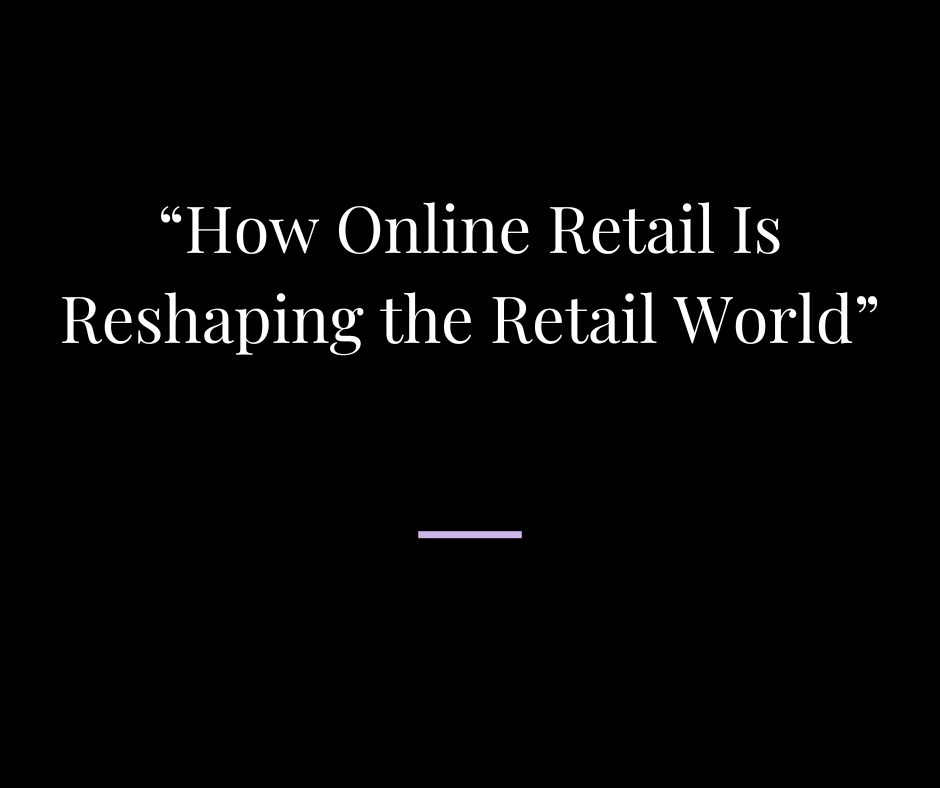How Online Retail Is Reshaping the Retail World

Must-Know Trends for Today’s Retail Landscape
-
Shift from Perfect Competition to Oligopoly
- Instead of creating a perfectly competitive market, online retail is increasingly dominated by a few large players (e.g., Amazon, Alibaba).
- High barriers to entry (start-up costs, tech requirements) limit the number of successful new e-tailers.
-
Importance of Customer Experience
- Technical expertise alone isn’t enough. Successful online retailers differentiate themselves with top-notch service, user-friendly interfaces, and trust-building measures.
- The growth of e-commerce puts pressure on traditional retail to innovate (moving toward “clicks-and-mortar” strategies).
-
Economic Growth & Job Creation
- E-commerce expands global reach for businesses of all sizes, fueling entrepreneurship.
- Key areas of job growth: logistics, warehousing, customer service, IT, digital marketing, and content creation.
-
Consumer Behavior & Spending Patterns
- Shoppers value convenience, accessibility, and the ability to browse anytime.
- Personalized recommendations and targeted ads encourage impulse buying and brand loyalty.
- Technologies (e.g., virtual try-ons, voice assistants) are shaping the future of consumer experiences.
-
Impact on Traditional Retail
- Many brick-and-mortar stores face closures or bankruptcies due to online competition.
- Omni-channel strategies (integrating online and offline) are crucial for survival:
- Seamless shopping experience (in-store pickup, website browsing, home delivery, etc.).
- Data-driven personalization and targeted promotions.
-
Supply Chain & Logistics Innovations
- Automated warehouses and robotics reduce errors and speed up order fulfillment.
- Drone deliveries and advanced tracking systems offer faster, more reliable shipping.
- The pandemic highlighted vulnerabilities in global supply chains and spurred calls for more resilience.
-
Technological Advancements
- Big Data & Analytics: Deep insights into consumer behavior enable better personalization and forecasting.
- AI & Automation: Chatbots and automated systems enhance customer service, inventory management, and warehouse operations.
-
Market Competition & Business Models
- Subscription services and direct-to-consumer (DTC) brands are on the rise.
- Smaller retailers compete by targeting niche markets, offering specialized products, and forming partnerships.
- Large marketplaces (Amazon, Alibaba) still set standards for pricing and delivery speed.
-
Economic Disparities & Inclusivity
- E-commerce can empower businesses in remote areas, but the digital divide (lack of reliable internet or tech access) remains a barrier.
- Government and private-sector initiatives are needed to improve connectivity and digital literacy.
-
Environmental Impact
- Packaging Waste: Over-packaging for safe delivery leads to significant waste.
- Carbon Footprint: Increased home deliveries, returns, and fast shipping options contribute to higher emissions.
- Sustainability Initiatives: Eco-friendly packaging, optimized logistics, and carbon offset programs are emerging solutions.
-
Conclusion
- Online retail is reshaping the global economy, consumer habits, and technology.
- Traditional retailers must adapt (omni-channel, improved customer experience) to stay competitive.
- Innovation and sustainable practices will be key to thriving in the evolving retail landscape.
Comparison Table: Traditional Retail vs. Online Retail
| Aspect | Traditional Retail | Online Retail |
|---|---|---|
| Market Structure | Many local/regional stores (fragmented) | Dominated by a few large players (oligopoly) |
| Barriers to Entry | Moderate (requires physical location) | High (tech infrastructure, competitive marketing) |
| Costs | High overhead (rent, utilities, staff) | Lower overhead (warehouse costs, automated ops) |
| Customer Experience | Face-to-face interaction, immediate product trials | Convenience, 24/7 access, personalization via AI |
| Growth Drivers | Local foot traffic, brand recognition | Global reach, data-driven personalization |
| Environmental Impact | Waste from store operations, physical commuting | Packaging waste, delivery emissions, product returns |
| Technological Use | Limited to POS systems and inventory Mgmt | Extensive: AI, automation, advanced analytics |
| Job Creation | Primarily in-store roles | Logistics, IT, digital marketing, customer support |
This summary is based on insights from the original article
Have questions about warehouse management or running your luxury resale business? Or perhaps you'd like to share your tips? We'd love to hear from you! Contact us at [email protected] or visit our website at stackknack.com to learn more. If you have any questions about running your luxury resale business, don't hesitate to reach out to us!